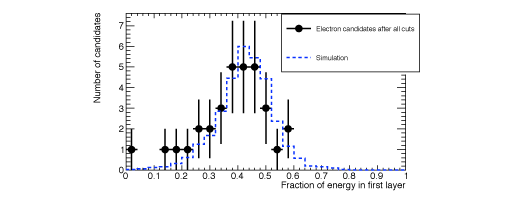
ATLAS e-News
23 February 2011
Cosmic electrons? Yes, if you look hard enough!
27 July 2009

Event display of an electron candidate from ionisation in the inner
detector volume. The incoming and outgoing muon tracks (in orange) are clearly seen on the left-hand plot, as reconstructed in three muon stations (top), in the inner detector (centre), and in two muon stations (bottom). The electron (green track) and its associated electromagnetic cluster and cells (dark green and blue) are also visible (centre).
For the first time, a set of electrons has been isolated from cosmic data collected in 2008. This will allow us to study the detector’s response to electrons and compare real data to simulated data.
Thanks to the steady stream of cosmic rays bombarding the Earth, commissioning the detector with muons is an accessible task. But testing ATLAS’s responses to electrons requires a bit more groundwork.
Diploma student Jana Kraus has isolated a sample of high-energy delta ray electrons, produced in the Inner Detector (ID) volume when cosmic muons ionise atoms. These electrons usually have energies of the order of thousands or millions of electronVolts (eV), but those occasional ones with energies at least a thousand times higher are able to reach the calorimeter and deposit at least 3 GeV of transverse momentum, the threshold needed to reconstruct the electromagnetic cluster of an electron.
High-energy delta rays are identified by the energy clusters they deposit in the calorimeter, in combination with the tracks they leave across the ID. But picking out these electrons in an analysis is not quite that simple. High-energy cosmic muons can masquerade as electrons in the detector, when they deposit energy through bremsstrahlung radiation.
Muons are minimum ionising particles, releasing very little energy when they go through the detector, but sometimes “the muon leaves energy in the calorimeter like a real electron does, and the track is also pointing to it,” says Jana, explaining how muons can fake an electron candidate.
Jana looked at 3.5 million events in the ID and within these found 11,000 electron candidates reconstructed by matching an energy cluster to an ID track. To narrow down which were real electrons and which were fakes, she performed two further levels of cut selections based on the characteristics of the tracks and clusters.
First, she separated the candidates into two sub-samples by looking at the number of tracks in the ID. In most cases, the cosmic events only left tracks in the TRT, since not all of them passed right through the centre of the detector. A real ionisation event leaves two tracks – the muon and the liberated electron – whereas single muons leave only one track. This selection procedure, together with several other cuts based on known electron properties, identified around 1200 events as bremsstrahlung muons, while only 85 events contained two tracks.
At the next level, Jana compared cluster energy with track momentum for each event. For electrons, this ratio should be around one; for muons it is smaller. Indeed, the two-track sample showed a clear peak around one, and the sample was narrowed down to those events which had an energy:momentum ratio between 0.8 and 2.5. She also compared the ratio of high- and low-threshold hits in the TRT, and made further cuts in the sample: electrons were expected to have a ratio higher than 0.08. The high threshold hits are produced only for relativistic particles. This is possible for a 1 GeV electron but muons would need more than 100 GeV to produce the transition radiation signal necessary to exceed the high threshold.
By looking at the 2-dimensional distribution of these two variables, Jana was able to identify 36 real electrons in the initial sample of 3.5 million events. In other words, about one in every hundred thousand cosmic events could be singled out as containing delta rays. The shape of the remaining underlying bremstrahlung muons was obtained from the one-track sample and subtracted out.

Candidate-electrons' fractions of energy deposited in the first layer of the electromagnetic calorimeter, alongside a Monte Carlo simulation of single electron events with energies of 5 GeV
“The efficiency of the method is not 100 per cent,” concedes Jana about the fact that electron candidates were cut from the sample unless they satisfied the tight electron identification criteria, “but in this way, I hoped to get the purest sample with only real electrons.”
Now that it has been isolated, Jana’s electron sample has been compared to Monte Carlo events and shows a fair agreement within the limited statistics, especially for the calorimeter shower shape variables. This analysis is the first step toward identifying electrons in the early data.

Ceri PerkinsATLAS e-News
|